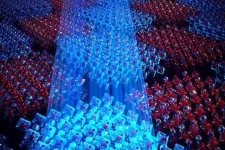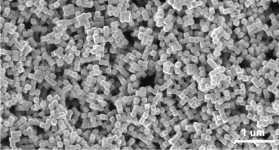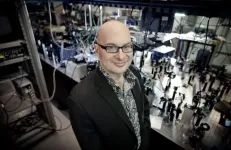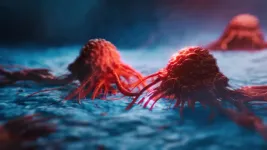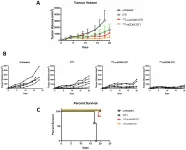Imagining a face reactivates face-detecting neurons in humans
Neurons encode different faces through distinct activity patterns that reactivate during recall
2021-01-11
(Press-News.org) Face-sensitive neurons in humans employ distinct activity patterns to encode individual faces; those patterns reactivate when imagining the face, according to research recently published in JNeurosci.
Human social interaction hinges on faces. In fact, faces are so important that the brain contains entire regions in the ventral temporal cortex devoted to facial recognition. In humans, the fusiform facial area activates in response to faces, and monkeys have single neurons that fire when shown a face. However, experimental limitations have prevented us from knowing how the human brain responds to and processes faces at the level of the single neuron.
To close this gap, Khuvis et al. measured the electrical activity of neurons in the ventral temporal cortex of eight adults undergoing invasive epilepsy monitoring. The participants viewed images of faces and other objects and then tried to remember and describe as many as possible. Groups of face-sensitive neurons activated in unique patterns while the participants viewed faces. That same group of neurons reactivated in the same pattern when a participant envisioned one of the faces they saw. Based on the activity pattern, the researchers were able to decode which face a person was seeing -- and even was thinking about.
INFORMATION:
Manuscript title: Face-Selective Units in Human Ventral Temporal Cortex Reactivate During Free Recall
About JNeurosci
JNeurosci, the Society for Neuroscience's first journal, was launched in 1981 as a means to communicate the findings of the highest quality neuroscience research to the growing field. Today, the journal remains committed to publishing cutting-edge neuroscience that will have an immediate and lasting scientific impact, while responding to authors' changing publishing needs, representing breadth of the field and diversity in authorship.
About The Society for Neuroscience
The Society for Neuroscience is the world's largest organization of scientists and physicians devoted to understanding the brain and nervous system. The nonprofit organization, founded in 1969, now has nearly 37,000 members in more than 90 countries and over 130 chapters worldwide.
[Attachments] See images for this press release:
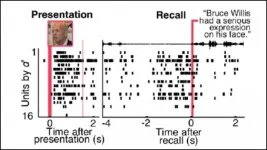
ELSE PRESS RELEASES FROM THIS DATE:
2021-01-11
HOUSTON - (Jan. 11, 2021) - Rice University engineers hope to make life better for those with replacement joints by modeling how artificial hips are likely to rub them the wrong way.
The computational study by the Brown School of Engineering lab of mechanical engineer Fred Higgs simulates and tracks how hips evolve, uniquely incorporating fluid dynamics and roughness of the joint surfaces as well as factors clinicians typically use to predict how well implants will stand up over their expected 15-year lifetime.
The team's immediate goal is to advance the design of more robust prostheses.
Ultimately, they say the model could help clinicians personalize hip joints for patients depending on gender, ...
2021-01-11
In most animal species, if a major artery is cut off from the heart, the animal will struggle to survive. The same can be said for many of our critical infrastructure systems, such as electric power, water and communications. They are networked systems with vulnerable connections.
This vulnerability was on display in September 2017 when Hurricane Maria wrecked Puerto Rico's electric power grid, leaving almost all of the island's 3.3 million people without electricity. The months-long blackout that followed was the worst in U.S. history.
Claire Trevisan, ...
2021-01-11
Oncotarget recently published "PD-1/PD-L1 expression in anal squamous intraepithelial lesions" which reported that the presence and distribution of CD8 lymphocytes and the presence of PD-1 lymphocytes and PD-L1 epithelial cells were assessed.
CD8 lymphocytes were observed more frequently in HSIL versus LSIL in the lamina propria or intra epithelial.
PD-1 lymphocytes were observed more frequently in HSIL versus LSIL.
There was no difference between HSIL and LSIL for PD-L1 epithelial cells.
Anal dysplastic lesions are accompanied by an inflammatory lymphocytic infiltrate expressing CD8 and PD-1, more frequent in high-grade lesions.
Dr. ...
2021-01-11
A team led by University of Minnesota Twin Cities researchers has discovered a groundbreaking one-step process for creating materials with unique properties, called metamaterials. Their results show the realistic possibility of designing similar self-assembled structures with the potential of creating "built-to-order" nanostructures for wide application in electronics and optical devices.
The research was published and featured on the cover of Nano Letters, a peer-reviewed scientific journal published by the American Chemical Society.
In general, metamaterials are materials made in the lab so as to provide specific physical, chemical, electrical, and optical properties otherwise impossible to find in naturally occurring materials. These materials can ...
2021-01-11
HOUSTON - (Jan. 11, 2021) - A sweet new process is making sour more practical.
Rice University engineers are turning carbon monoxide directly into acetic acid -- the widely used chemical agent that gives vinegar its tang -- with a continuous catalytic reactor that can use renewable electricity efficiently to turn out a highly purified product.
The electrochemical process by the labs of chemical and biomolecular engineers Haotian Wang and Thomas Senftle of Rice's Brown School of Engineering resolves issues with previous attempts to reduce carbon monoxide (CO) into acetic acid. Those processes required additional steps to purify ...
2021-01-11
(Boston)--Little previous research has examined the effects of Dense Breast Notifications (DBNs), but a new study suggests the legislatively required notifications have achieved partial success: women living in states in which in DBNs are mandated had higher rates of being informed about personal breast density and of having had breast density discussions with providers, though rates were low overall.
DBNs are a written notification to a woman after a mammogram with information about breast density. The goal is to motivate her to speak with her doctor about her personal risk and determine if supplemental screening for breast cancer is appropriate. DBNs are mandated in more than 38 states and the Food Drug ...
2021-01-11
Scientists from the University of Bath have made a sustainable polymer using the second most abundant sugar in nature, xylose.
Not only does the new nature-inspired material reduce reliance on crude oil products, but its properties can also be easily controlled to make the material flexible or crystalline.
The researchers, from the University's Centre for Sustainable and Circular Technologies, report the polymer, from the polyether family, has a variety of applications, including as a building block for polyurethane, used in mattresses and shoe soles; as a bio-derived alternative to polyethylene glycol, a chemical widely used in bio-medicine; or to polyethylene oxide, ...
2021-01-11
An international team of researchers, including Professor END ...
2021-01-11
PHILADELPHIA -- (Jan. 11, 2020) -- Mutations that inactivate the ARID1A gene in ovarian cancer increase utilization of the glutamine amino acid making cancer cells dependent on glutamine metabolism, according to a study by The Wistar Institute published online in Nature Cancer. Researchers also showed that pharmacologic inhibition of glutamine metabolism may represent an effective therapeutic strategy for ARID1A-mutant ovarian cancer.
Up to 60% of ovarian clear cell carcinomas (OCCC) have inactivating mutations in the ARID1A tumor suppressor gene. These ...
2021-01-11
Oncotarget recently published "Targeted lymphodepletion with a CD45-directed antibody radioconjugate as a novel conditioning regimen prior to adoptive cell therapy" which reported that Chimeric antigen receptor T cell therapies, and adoptive cell therapy in general, represent one of the most promising anti-cancer strategies.
In contrast to relatively non-specific chemotherapy-derived lymphodepletion, targeted lymphodepletion with radioimmunotherapy directed to CD45 may be a safer and more effective alternative to target and deplete immune cells. Here the authors describe the results ...
LAST 30 PRESS RELEASES:
[Press-News.org] Imagining a face reactivates face-detecting neurons in humans
Neurons encode different faces through distinct activity patterns that reactivate during recall



